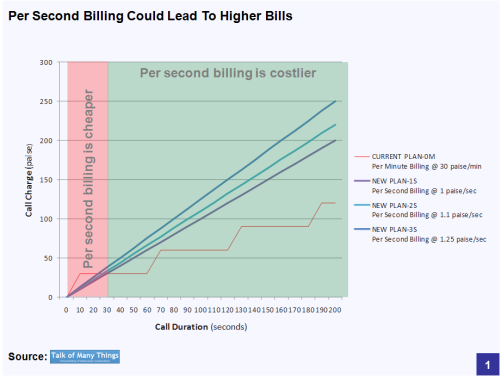A couple of weeks ago, I’d written about why, contrary to popular opinion, per second billing tariff plans do not portend financial ruin for mobile network operators (Click here and here).
In the last few days, several MNOs have announced per second billing plans and we’ve started seeing the results. The media is gradually dropping its former scare mongering tone about the negative impact of per second billing on the revenues of MNOs. In fact, there’s now growing realization that there’s more to per second billing than meets the eye, even to the extent of admitting that it’s not exactly manna from heaven for subscribers as it was portrayed a couple of weeks ago.
In its recent article ‘Per second’ billing: Devil lies in the detail, the Economic Times takes the case of one Mr. Sahil Shah who was using a 30 paise per minute plan. Presumably caught up in the media frenzy over how per second billing would lead to lower costs – untrue as my previous blog posts have shown – he shifted to a per second plan. Had his MNO exactly prorated its per minute plan, Mr. Shah would’ve been able to sign up for a new plan costing 0.5 paisa per second. Apparently that didn’t happen since, according to the article, Mr. Shah’s new plan carried a charge of 1 paisa per second plan, which is twice as expensive compared to his older 30 paise per minute plan. Now, when I say that Mr. Shah’s average call duration was three minutes, those of you who’ve seen the charts in my previous posts will figure out the ending of this story immediately: poor Mr. Shah got a rude shock when he found himself exhausting his fortnight’s talktime in just a week because his average call that used to cost him 3 x 30 = 90 paise under his old per minute plan now cost him twice as much (180 x 1 = 180 paise) with his new per second billing plan.
By recasting the chart from my previous post using the 30 paise per minute plan as the new baseline, it becomes evident that per second billing results in higher charges for call durations exceeding 30 seconds.

(Click here to download ver 02 of the Excel-based mobile phone call charge calculator.)
The ET article confirms what readers of my previous posts already know and others can see from the above chart – call charges depend upon individual usage patterns and the manner in which tariff plans are structured. Mr. Sahil Shah’s experience signals the need for subscribers to carefully evaluate whether a per second billing plan really suits their own calling behavior instead of signing up to them in a frenzy and regretting their decison later. This Excel-based calculator can help them do this.
Pingback: Mobile Subscribers Can Vote With Their Wallets, or, hmmm, Handsets « Talk of Many Things